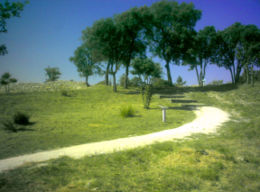
Cividade Hill
Encyclopedia

Póvoa de Varzim
Póvoa de Varzim is a Portuguese city in the Norte Region and sub-region of Greater Porto, with a 2011 estimated population of 63,364. According to the 2001 census, there were 63,470 inhabitants with 42,396 living in the city proper. The urban area expanded, southwards, to Vila do Conde, and there...
in Portugal
Portugal
Portugal , officially the Portuguese Republic is a country situated in southwestern Europe on the Iberian Peninsula. Portugal is the westernmost country of Europe, and is bordered by the Atlantic Ocean to the West and South and by Spain to the North and East. The Atlantic archipelagos of the...
. The hill is located in the parish of Terroso
Terroso
Terroso is a Portuguese parish located in the municipality of Póvoa de Varzim. In the census of 2001, it had a population of 2,472 inhabitants and a total area of 4.63 km²....
, just east of the city, and is the second highest hill in the municipality, after São Félix Hill; these hills are sequence of the small mountain range known as Serra de Rates.
In the hilltop, there's Cividade de Terroso
Cividade de Terroso
Cividade de Terroso was an important city of the Castro culture in North-western Iberian Peninsula, located in Póvoa de Varzim, Portugal.The city, known in the Middle Ages as Civitas Teroso, was built at the top of Cividade Hill, in the parish of Terroso, in Póvoa de Varzim, less than 5 km...
, an ancient Castro culture
Castro culture
Castro culture is the archaeological term for naming the Celtic archaeological culture of the northwestern regions of the Iberian Peninsula from the end of the Bronze Age until it was subsumed in local Roman culture...
city with about 3000 years old, meanwhile it was inhabited only for one thousand years.
Surrounding the hill, some tumuli are known, dating from the beginning of the permanent habitation of the region, 4 to 6 thousand years ago, and thus much older than the Castro town itself.

